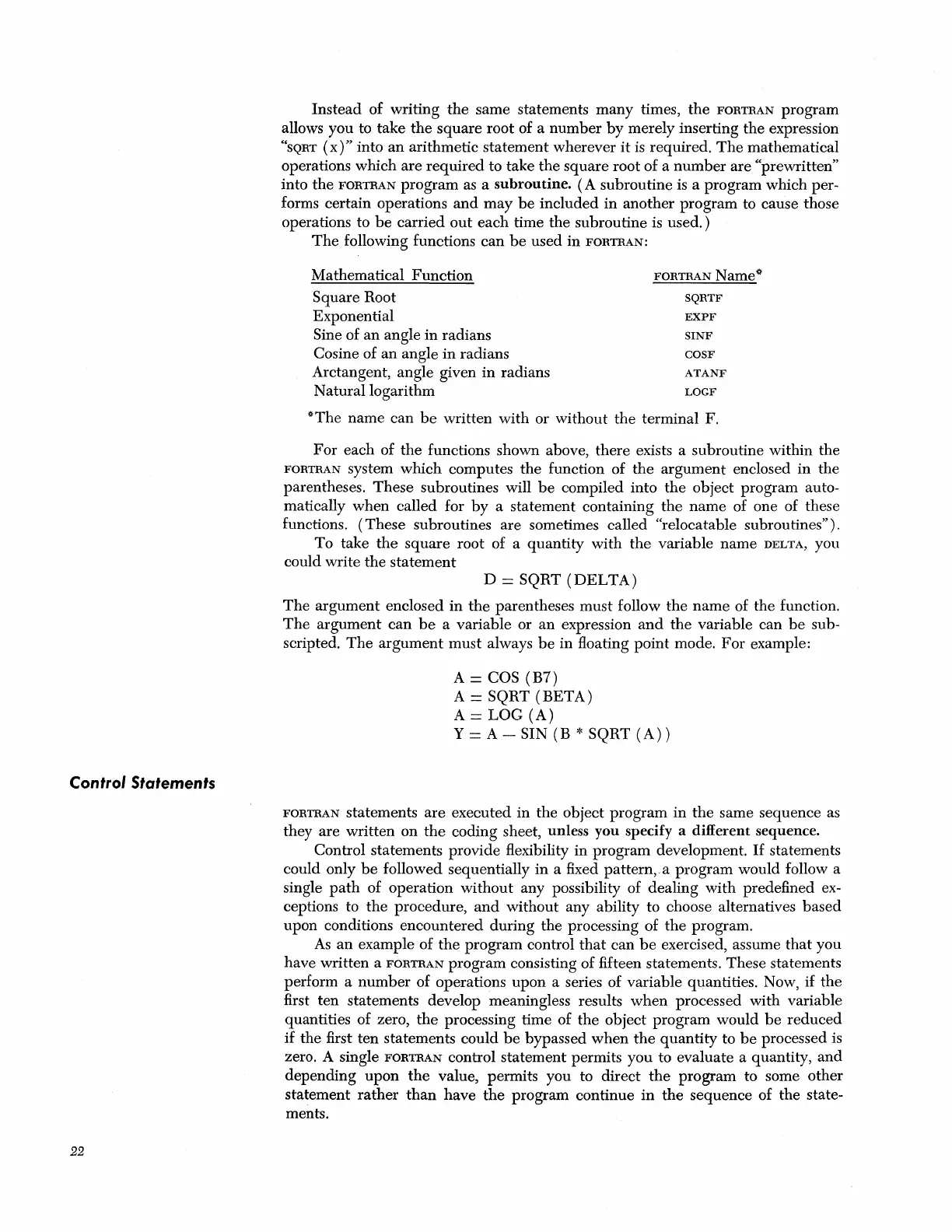Control Statements
22
Instead
of
writing
the
same
statements
many
times,
the
FORTRAN
program
allows
you
to
take
the
square
root of a
number
by
merely inserting
the
expression
"SQRT
(x)"
into
an
arithmetic
statement
wherever
it
is
required.
The
mathematical
operations which
are
required
to take
the
square
root of a
number
are
"prewritten"
into
the
FORTRAN
program
as
a
subroutine.
(A
subroutine is a program which per-
forms certain operations
and
may
be
included
in
another
program
to cause those
operations to
be
carried
out
each
time
the
subroutine is
used.)
The
following functions
can
be
used
in
FORTRAN:
Mathematical
Function
Square Root
Exponential
Sine of
an
angle
in
radians
Cosine of an angle
in
radians
Arctangent, angle given
in
radians
N
aturallogarithm
FORTRAN
Name~
SQRTF
EXPF
SINF
COSF
ATANF
LOGF
~The
name can
be
written
with
or
without
the
terminal F.
For
each of
the
functions shown above,
there
exists a subroutine within
the
FORTRAN
system
which
computes
the
function of
the
argument
enclosed
in
the
parentheses.
These
subroutines will
be
compiled into
the
object program auto-
matically
when
called for
by
a statement containing
the
name
of one of these
functions.
(These
subroutines are sometimes called "relocatable subroutines").
To
take
the
square
root of a
quantity
with
the
variable
name
DELTA,
you
could write
the
statement
D = SQRT
(DELTA)
The
argument
enclosed
in
the
parentheses
must
follow
the
name
of the function.
The
argument
can
be
a variable or
an
expression
and
the
variable can
be
sub-
scripted.
The
argument
must
always
be
in
floating point mode.
For
example:
A
= COS (B7)
A
= SQRT
(BETA)
A =
LOG
(A)
Y = A - SIN
(B
* SQRT
(A)
)
FORTRAN
statements
are
executed
in
the
object
program
in
the
same sequence as
they
are
written on
the
coding sheet, unless you specify a different sequence.
Control statements provide flexibility
in
program
development.
If
statements
could only
be
followed sequentially
in
a fixed pattern,. a
program
would follow a
single
path
of operation
without
any possibility of dealing
with
predefined
ex-
ceptions to
the
procedure,
and
without
any ability to choose alternatives
based
upon conditions
encountered
during
the
processing of
the
program.
As
an
example of
the
program
control
that
can
be
exercised, assume
that
you
have
written
a
FORTRAN
program
consisting of fifteen statements. These statements
perform a
number
of operations
upon
a series of variable quantities. Now,
if
the
first
ten
statements develop meaningless results
when
processed
with
variable
quantities of zero,
the
processing time of
the
object
program
would
be
reduced
if
the
first
ten
statements could
be
bypassed
when
the
quantity
to
be
processed is
zero. A single
FORTRAN
control
statement
permits
you
to evaluate a quantity,
and
depending
upon
the
value, permits you to
direct
the
program
to some
other
statement
rather
than
have
the
program continue
in
the
sequence of
the
state-
ments.
